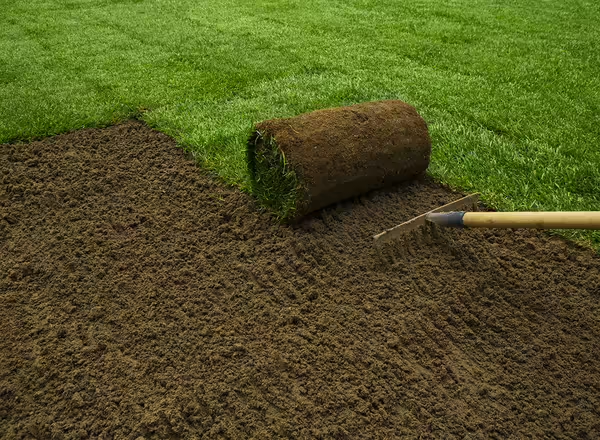
Preparing Lawn Soil and Site
Success or failure of a home lawn is closely tied into how well the soil and site was prepared prior to lawn establishment.
Eliminating weed problems existing on the site is an important first step. Perennial weeds, such as quackgrass or tall fescue, need to be controlled prior to lawn seeding or sodding. Weed control options include digging by hand, repeated soil tillage or using a systemic (moves within plant) nonselective herbicide, such as glyphosate. Some weeds are promoted by control measures such as tilling goosegrass, which actually promotes more germination of this weed. Organic products are becoming more popular as well. Read, understand, and follow all label directions whenever using any type of control product to be sure you will be getting the expected level of control necessary.
Before seeding or sodding, it's important to open the soil surface to receive the seed. Amend poor soils, such as heavy clay, by incorporating organic matter into the soil. Sources include compost, rotted manure, peat, and quality topsoil. Sand is not suggested as a material to improve clay soils for home lawns.
Thick layers of arborist wood chips can also be used to mulch the soil and add organic matter, but this process may take a year or longer for the material to break down. If you have time, it is a viable option. Once the mulch breaks down the area can be seeded or sodded.
In addition to modifying the soil structure organic matter contains microorganisms that work together with the roots of plants to absorb the nutrients in the soil and improve the water holding capacity. There are many benefits of using organic matter as part of the soil building program. However, not all Illinois soil needs additional organic matter. A soil test can help indicate a soil’s organic matter content.
Incorporate ammendments into the existing soil. A goal is to have six inches or more of well prepared soil. Avoid amending soil around large trees where many roots are found within the dripline. Root zones of trees are recommended to be mulched as they are directly competing with turfgrass.
Soil testing is suggested prior to establishment and should be done during the planning process. Soil testing reveals the soil pH and amount of available nutrients such as phosphorus (P) and potassium (K). If major modifications are needed, it is easier to make these prior to establishing the lawn. Check with your local Extension Office for details on how to take a soil test or check out soils website which includes lists of commercial soil labs to send samples.
Starter fertilizers are only necessary if a soil test indicates a deficiency in phosphorous. Start fertilizers are either mixed into the soil surface prior to lawn establishment or spread after seeding. These are typically high in phosphorous, which Illinois soils tend to have more than enough to supply a young lawn. Balanced fertilizers typically have balanced ratios of nitrogen, phosphorus, and potassium (N, P, K), such as 10-10-10 or 12-12-12. If a soil tst indicates a phosphorus or potassium deficiency, a balanced fertilizer can be used if a starter fertilizer is not available.
When preparing the soil, it's important to establish a favorable final grade. Rough grading should include removal of any rock or other debris. Avoid burying construction debris, as this could cause problems for the grass later. Eliminate any depressions or raised areas. Final slopes should be one to two percent away from buildings (1 to 2 feet drop per 100 feet of run) to assure adequate surface drainage.
Soil preparation should be done when the soil is not too dry or wet as tillage will destroy soil structure, and create problems with air and water holding capacity and drainage after a rain event. It can take years to return to its former state.
Taking shortcuts in soil and site preparation often leads to assorted lawn problems later. Take the time and effort to do a thorough job before seeding or sodding that includes soil testing, nutrient and soil amendments, creating uniformity of the subsoil and final grading.

- Conduct soil tests to determine soil fertility
- Kill and remove any weeds
- Till/harrow to open up the soil surface for seed or sod
- Rough grade to avoid any potential drainage problems during the project and rocks and debris
- Amend soil as necessary according to the soil test to a depth of 6- to 8-inches
- Final grade maintaining a 1 to 2 percent slope away from buildings.
- If excessive tilling has produced a fluffy soil surface, a lawn roller or weighted drag can help firm up the soil surface.